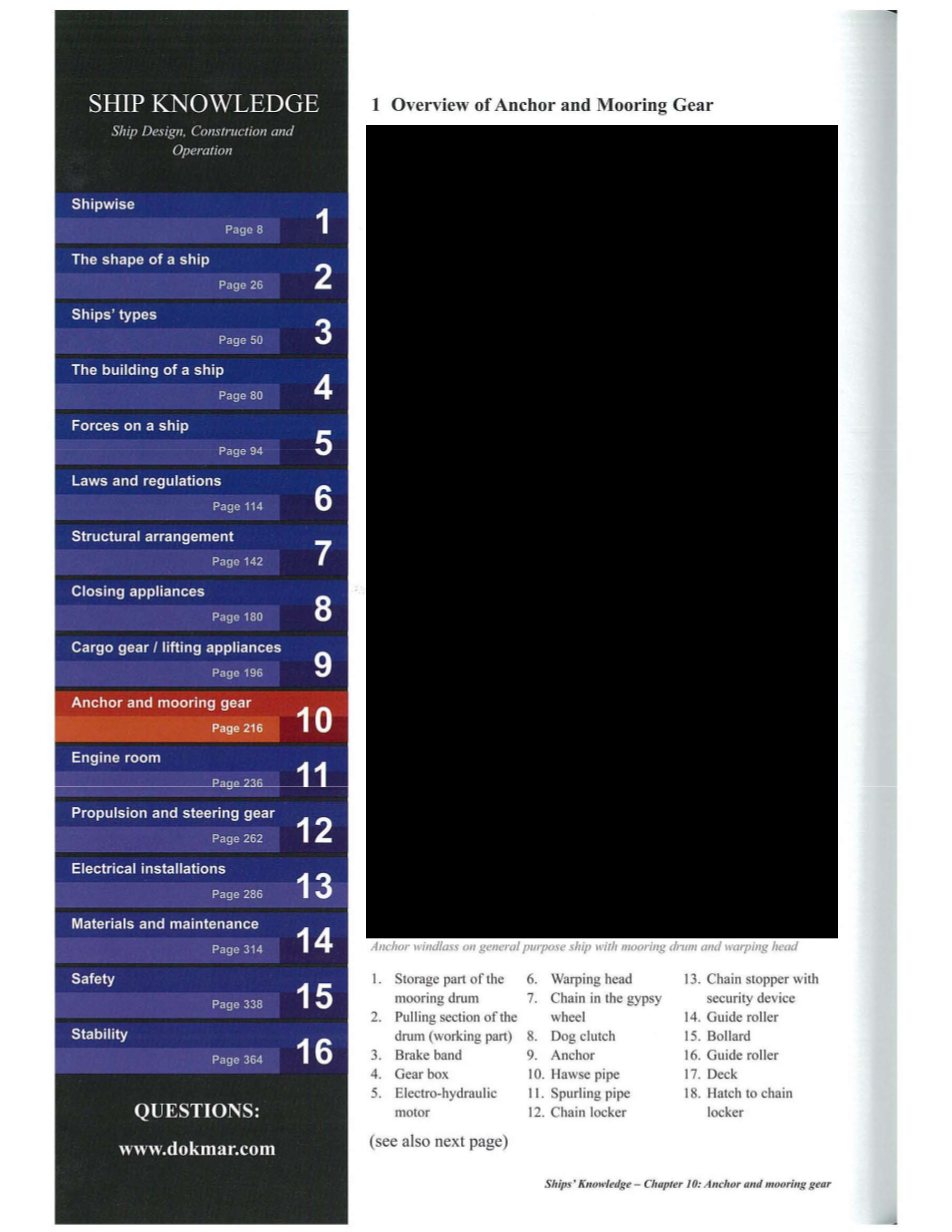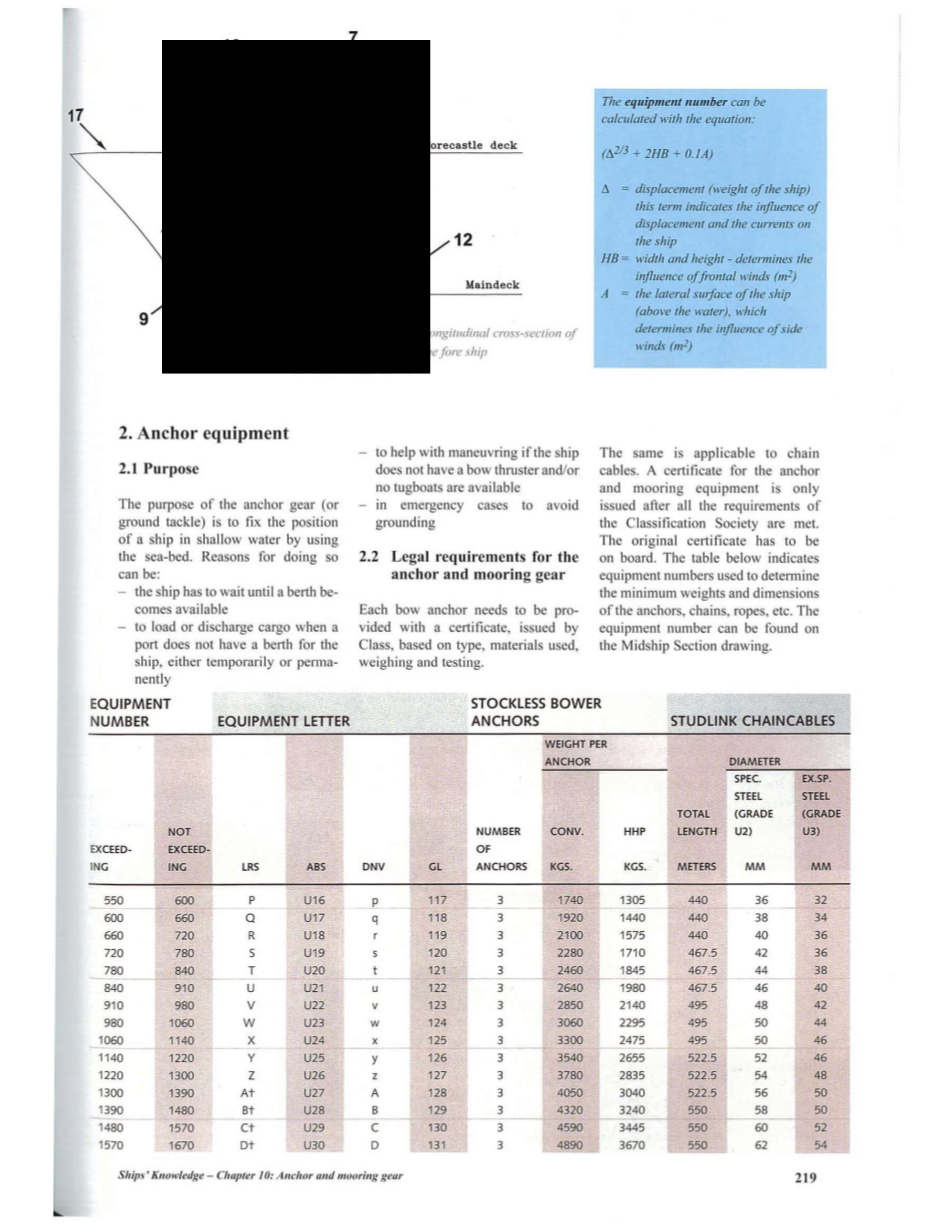

英语原文共 18 页,剩余内容已隐藏,支付完成后下载完整资料
|
1 Overview of Anchor and Mooring Gear |
1.锚和系泊设备概述。 |
|
1. Storage part of the mooring drum 2. Pulling section of the drum (working part) 3. Brake band 4. Gear box 5. Electro-hydraulic motor 6. Warping head 7. Chain in the gypsy wheel 8. Dog clutch 9 Anchor 10 Hawse pipe 11. Spurling pipe 12. Chain locker 13. Chain stopper with security device 14. Guide roller 15. Bollard 16. Guide roller 17. Deck 18. Hatch to chain locker |
1.系泊滚筒的储存部分 2.滚筒牵引段(工作部分) 3.刹车带。 4.齿轮箱 5.电动液压马达 6.绞缆筒 7.锚链轮上的链 8.爪形离合器 9.锚 10.锚链筒 11.锚链管 12.链锁 13.带安全装置的止链器 14.导辊 15.带缆桩 16.导辊 17.甲板 18.锚链舱舱口 |
|
2. Anchor equipment |
2. 锚设备 |
|
2.1 Purpose The purpose of the anchor gear(or ground tackle) is 10 fix the position of a ship in shallow water by using the sea-bed. Reasons for doing so can be: -the ship has to wait until a berth becomes available -to load or discharge cargo when a port does not have a berth for the ship, either temporarily or permanently. -to help with maneuvring if the ship does not have a bow thruster and/or no tugboats are available -in emergency cases to avoid grounding |
2.1目的 锚具(或地滑车)的作用是利用海床在浅水中固定船舶的位置。这样做的情形有: -船必须等到有泊位时才能靠泊 -在港口暂时或永久没有泊位的情况下装卸货物 -在船只没有船首推力器及/或没有拖船的情况下,协助操作。 -紧急情况下避免接地 |
|
2.2 Legal requirements for the anchor and mooring gear Each bow anchor needs to be provided with a certificate, issued by Class, based on type, materials used, weighing and testing. The same is applicable to chain cables. A certificate for the anchor and mooring equipment is only issued after all the requirements of the Classification Society are met. The original certificate has to be on board. The table below indicates equipment numbers used to determine the minimum weights and dimensions of the anchors, chains, ropes, etc. The equipment number can be found on the Midship Section drawing. |
2.2锚和系泊设备的法律要求 每一个船首锚都必须具有一个证书,证书由船级基于类型,使用的材料,进行称重和测试后颁发 这同样适用于链电缆。只有在符合船级社的所有要求后,才可签发锚和系泊设备证书。原件必须在船上。下表显示了用于确定锚、链、绳等的最小重量和尺寸的设备编号。设备编号见船中剖面图。 |
|
2.3 Anchors Anchors are the final safety resource of a ship. From ancient times, the men using them had a stone on a sling to keep the boat in position. Later developments show combinations with wood, ending in the stock anchor (fisherman#39;s anchor) with wooden stock. When propulsion or steering fails, the seafarer has to rely on his anchoring equipment. It is therefore of utmost importance that this equipment is in good condition. A regular check of the condition of the anchor itself, the crown, anchor shackle, the chain cable, windlass, brake band and anchor securing arrangements is the responsibility of the master. In general, ships have two bow anchors and sometimes a stern anchor. There are two bow anchors for safety. Under normal circumstances one anchor is sufficient, but under severe weather conditions or in strong current both anchors may be needed. Also, if one anchor fails, the second anchor is a back-up. Normally a ship is not allowed to sail from any port when one anchor has been lost. The Classification Bureau may allow departure under the condition that replacement is carried out at the earliest opportunity and that the vessel takes additional tug assistance leaving and entering port. The stern anchor is used to prevent ships (coastal trade liners, for example) from rotating due to tidal changes in a river current. Anchors can be: -Conventional anchors -HHP anchors (high holding power) -SHHP anchors (super high holding power) Common conventional anchor types are Spek, Hall, Union and Baldt. Spek anchors have the advantage of being fully blllanced. A fully balanced anchor has the following advantages: -an anchor recess that completely -envelops the anchor, can be used -the shell cannot be easily damaged during heaving when the anchor flukes leave the water vertically Accepted HHP anchors are ACI4,Pool and Danforth. CQR lind Plowtype anchors are only used on small craft. Various copies of accepted types are made all over the world. A fully balanced anchor means that when the anchor is being weighed,lifted from the seabed into the hawse pipe with the flukes verticlll, the weight of the head serves as being a counterweight. Such an anchor is never fouled, i.e. with the flukes pointing into the ship#39;s shell. The conventionlll type is still used a lot and serves as a standard for newer types of anchors (see table). Conventional anchors are always cast. Newer types, such as Pool, can also consist of plates (or other components) thllt are welded together. If the flukes are hollow, they tend to be more resistant towards bending forces. The crown plate ensures that the flukes of the anchor penetrate the sea floor. In certain types of anchors, flukes prevent the anchor from burying itself too deeply in the sea bottom. The navy uses a specially developed HHP anchor with an open crown 全文共38773字,剩余内容已隐藏,支付完成后下载完整资料 资料编号:[3051] |


